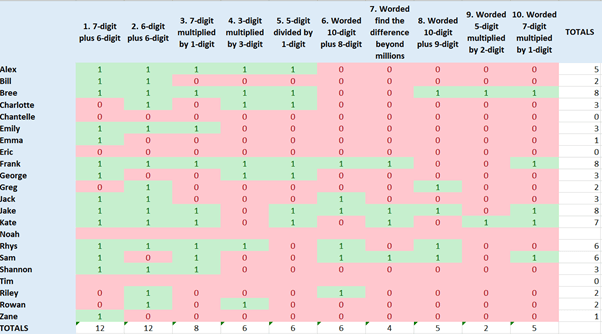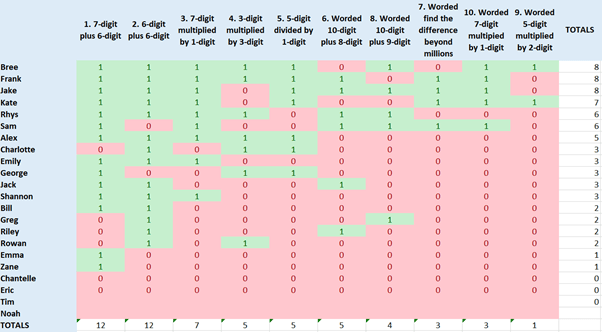
By Chris Allen
EDITION #2 – How do I built great relationships?
Published – 6th March 2019

Group and individual learning goals ensure that students are working with clear purpose and direction.
A crucial stage in the assessment process is to take the data you have gathered and use it to form personal learning goals for your students. By analysing the data to identify what skills your students still need to focus on, you are catering for the individual needs of your students and maximising the time spent in the classroom. In this article I will provide an example of the data I collect and how I analyse it to create learning goals.
Forming group and individual learning goals using pre-assessment data at the beginning of a unit ensures that students are working from the very beginning with clear purpose and direction and enables them to take responsibility for moving their learning forward. When students achieve goals during a unit of work, new goals can be set by comparing their pre-assessment data to the work they have completed. This enables new goals to be set and allows both teachers and students to determine whether or not they are on track.
It is easy for both teachers and students to slip into the mindset of thinking that at the end of a unit of work the learning in that content area is finished. However, by analysing the post-assessment data gathered upon completion of the unit, personal learning goals can be set for students to continue working in this area in their own time, whether it be for extra support or as an extension and application of higher knowledge.
Pre and post assessment in my classroom
I link assessment to group and individual learning goals throughout the school year.
I link assessment to group and individual learning goals across the school year through the use of pre and post-assessment tasks, as well as small group and individual conferences.
After conducting a pre-assessment at the start of a Mathematics unit, I enter the data into a Guttman Chart using Excel (see Figure 1). The chart is set out with student names on the y axis, and the question number and skill being tested in each question on the x axis. Students are given a ‘0’ for incorrect answers, and ‘1’ for correct, which are programmed to display in different colours. Once the data has been entered, the graph can be sorted in a way that shows the questions that were answered correctly by the most students on the left of the screen, and the questions that were answered incorrectly by the most students on the right of the screen (see Figure 2). This allows me to easily identify groups of students who are struggling with similar concepts in Mathematics, assign each group an appropriate goal for their needs and differentiate my teaching to support their learning.

Figure 2: Guttman Chart with raw, unsorted data from multiplication pre-assessment

Figure 3: Same data from Figure 1, but sorted by highest-to-lowest scoring student, and
highest-to-lowest scoring question based on number of times it was answered correctly
I use a similar process when I teach Reading by introducing students to strategies focussing on comprehension, accuracy, fluency and vocabulary. Through conferencing with individuals and listening to and observing them reading, I identify the strategies they need to work on. We then collaboratively construct individual learning goals and steps they can take to achieve those goals.
Find out the process at your school
Ask your mentor to explain the processes used at your school.
The school at which I am currently working uses the Single Word Spelling Test (GL Assessment, 2017) to identify student strengths and areas for development. This data is then used to form groups of students with similar abilities, with different goals for each group.
The secondary sector of my current school links assessment to Reading goals in a very similar fashion, conducting individual and small group conferences to identify the next logical step to take in their development. The year 7-8 teachers use a very similar approach when creating Writing goals. By conducting a pre-assessment at the start of each unit of work, such as narrative or persuasive writing, they are able to analyse the work samples of each student and identify the next area of focus they need to take to move their learning forward. They then conference with each individual student, sharing and explaining the feedback with them, and collaboratively forming an appropriate goal.
The first school I worked at used a different approach which focussed more on forming individual spelling, grammar and punctuation goals. This was done by reading a passage of text aloud to students, who would then be required to dictate the passage right down to placement of full stops and commas. Errors were then analysed, and individual goals formed based on the areas of need identified for each individual.
The research on feedback as part of assessment is strong
Providing feedback to students is a crucial stage in the assessment process.
The research of John Hattie (2012), has emphasised the importance of providing feedback to students as a crucial stage in the assessment process. Feedback is also one of the ten strategies identified in the High Impact Teaching Strategies document published by the Department of Education and Training and used in government schools across Victoria. As outlined in the document, feedback allows students to participate in meaningful discussions with their teacher regarding their learning and allows both parties to act on the feedback by creating individual learning goals that target their needs. Creating a classroom culture where feedback on learning is given promptly and flows into the construction of goals also greatly increases the sense of ownership and responsibility that students have for their learning (Hattie, 2012).
Gail Boushey and Joan Moser (2011) state that before setting individual and small group learning goals for their students, they were using a style of teaching where all students were working through the same content, with struggling students showing little-to-no growth as a result. To combat this issue, they developed and trialled The Daily 5, an approach to literacy teaching and learning where students engage in purposeful and meaningful independent work whilst teachers conference with individuals and small groups. It is in these conferences that Boushey and Moser (2011) started guiding and coaching their students to reflect on and identify their strengths and areas of need and then develop appropriate goals to meet these needs. At the end of these conferences, students had developed with their teacher specific strategies they could work on independently to achieve those goals.
The major benefit noted by Boushey and Moser (2011) from adopting this approach of conferencing with students to set learning goals is the increase in student engagement with their learning. They attribute this rise in engagement levels to the greater sense of purpose and direction that all students have; each student knows what their learning goal is for each subject area, and what steps they can take to achieve each goal.
Evidence-based resources to build your assessment practice
Emphasis is placed on a conversation between teacher and student.
A series of assessment documents and guides
The Department of Education and Training have released policies and resources on Assessment https://www.education.vic.gov.au/school/teachers/teachingresources/practice/Pages/assessment.aspx . You should be familiar with these documents, if you are unsure about the content, ask your mentor. These resources source evidence that shows improvements to student learning and wellbeing occurs when individual learning goals are set. Increases can be seen in motivation and participation, and students are able to successfully attempt more challenging tasks as they can look back on previous achievements to see how far they have progressed.
The High Impact Teaching Strategies: Setting goals
The Department’s High Impact Teaching Strategies (HITS) draw on the research and processes of setting learning goals that I have described in the work of Boushey and Moser (2011), and Hattie (2012). Rather than students being provided with goals that have been developed by the teacher, emphasis is put on a conversation taking place between teacher and student, with the student being guided and prompted by the teacher to identify areas of need. In addition to this, they highlight the importance of teachers guiding the student to reflect on how effective the strategies were in helping them achieve their goal.
Reading the data and creating learning goals
To successfully link assessment to group and individual learning goals it is imperative that you understand what the assessment data is telling you.
Guttman Charts are an effective tool for figuring out what students need to learn next. As seen earlier in Figure 2, after sorting the raw data, Guttman charts give a clear visual representation of the gaps in student learning. In that chart they are highlighted in red. You can use the charts to focus on individual students and the skills that they need to develop (see Figure 3), or groups of students who are struggling in the same area (see Figure 4).

Figure 1: Bree is able to solve multiplication problems involving number sentences,
but needs to improve her ability to solve worded problems

Figure 2: Alex, Charlotte, Emily and George were all unable to get any worded problems write.
This would be a suitable goal for them to work on together
Once an area for skill development has been identified, it is important to create and communicate the goal in a way that makes sense to the students and empowers them to independently move forward with their learning.
I set goals with my students in individual or small group conferences. I share and discuss their assessment results with them, and together we identify a specific skill or strategy that they need to improve. For Bree, looking at her results in Figure 3, I would guide her towards improving her ability to solve worded problems involving large numbers up to and beyond millions. I would ask her to solve these types of problems in front of me, and together we would discuss he progress and any areas where she may still be making a mistake.
We would then start shaping her goal together; the start to the goal might read something like: ‘I am working on checking my working out…’. We then discuss why it is important to improve this skill and how it will help in the future which allows the student to see the relevance of the goal and lets them feel ownership over what they are doing. This section of the goal nearly always starts with ‘so that’, and in this might read as: ‘…so that I can identify any errors and try to fix them’, or ‘…so that I can identify any errors and attempt to fix them myself before submitting my work’.
The final step is to equip students with strategies and resources they can use to work towards achieving the goal independently. I do this during the conference by first asking the student what they think they could do to work on their goal, and then by modelling any strategies that we have agreed could be beneficial to them. We then collaboratively use the strategy on another problem. I ask the student to use the strategy independently without any input from me. Once both myself and the student feel confident that they understand and can have some success with each step of the strategy or strategies they are going to be using, the student receives a written copy of the goal with our next conference date listed on it where we will review their progress.
When I first started setting and monitoring the progress of goals with students, I found that students were forgetting what their goal was, and that I was struggling to get around all students to track their progress and review their goals. To help students remember what their goals are, I provide them with a bookmark that has their goal written on it and the strategies they can use to work towards achieving it. I print goals for each subject on a certain colour to help students quickly find the relevant goal for the lesson they are working on (see Figure 5).

In order to ensure I am conferencing with all students on a regular basis I use an online calendar and conferencing system called CC Pensieve (www.ccpensieve.com). This online system allows me to book conferences for students in any subject area, and also allows me to enter and save detailed notes about each student and the specific goals they are working on. The calendar system has greatly increased my efficiency, as it keeps me accountable and helps to ensure I am regularly meeting with all students.
References
GL Assessment 2017, ‘GL Assessment’, viewed 17 October 2018, https://www.gl-assessment.co.uk/sellingline/swst?productNodeId=2234
Hattie, J. 2012, Visible Learning for Teachers: Maximising Impact on Learning, Routledge, Abingdon.
Boushey, G. & Moser, J. 2011, The CAFE Workshop, Stenhouse Publishers, Portsmouth, NH.
